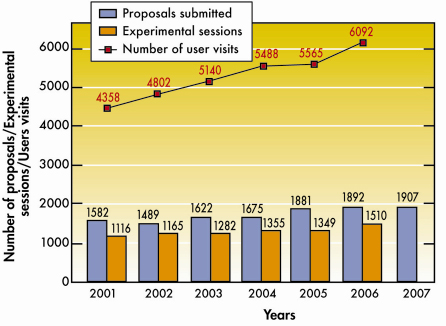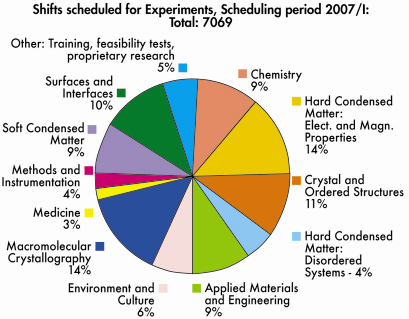User operation
After more than a decade of successful operation of the facility for scientific Users, the year 2007 saw the full complement of 31 public beamlines, together with 11 additional beamlines operated by Collaborating Research Groups (CRGs) available for experiments by visiting research teams.
Figure 151 shows the increase in the number of applications for beamtime since 2001, and confirms that although the main beamline construction effort was complete by 1999, the number of applications for beamtime continues to increase steadily.
 |
|
FIG .151: Numbers of applications for beamtime, experimental sessions and user visits, 2001 to 2007. N.B. Final numbers of experiments and user visits for 2007 were not available at the time of going to press. |
Proposals for experiments are selected and beamtime allocations are made through peer review. Review committees of specialists, for the most part from European countries and Israel, have been set up in the following scientific areas:
• chemistry
• hard condensed matter: electronic and magnetic properties
• hard condensed matter: crystals and ordered systems
• hard condensed matter: disordered systems and liquids
• applied materials and engineering
• environmental and cultural heritage matters
• macromolecular crystallography
• medicine
• methods and instrumentation
• soft condensed matter
• surfaces and interfaces
The Review Committees met twice during the year, some six weeks after the deadlines for submission of proposals (1 March and 1 September). They reviewed a record number of 1907 applications for beamtime, and selected 888 (46.6%), which were then scheduled for experiments.
Features of this period:
• increasing numbers of proposals submitted for research into environmental issues, into palaeontology and artefacts relating to our cultural heritage.
• the continued successful operation of the Block Allocation Group (BAG) scheme for macromolecular crystallography users. This scheme, designed to encourage groups of users to block together their multiple requests for beamtime, and the scheduling of their experiments, encompassed 48 groups from Europe and Israel in 2007.
Requests for beamtime, which is scheduled in shifts of 8 hours, totalled 29 959 shifts or 239 672 hours in 2007, of which 13 681 shifts or 109 448 hours (45.7%) were allocated. The distribution of shifts requested and allocated, by scientific area, is shown in Table 7.
 |
|
Table 7: Number of shifts of beamtime requested and allocated for user experiments, year 2007. |
The breakdown of shifts scheduled for experiments by scientific area in the first half of 2007 is shown in Figure 152. This period saw 2799 visits by scientists to the ESRF under the user programme, to carry out 691 experiments. Figure 151 shows the rapid rise in the number of user visits since 2001, the higher numbers in recent years reflecting in part the multiple visits made by macromolecular crystallography BAG teams.
 |
|
Fig. 152: Shifts scheduled for experiments, March to July 2007, by scientific area. |
Overall, the number of users in each experimental team averaged 4 persons, and they stayed for some 4 days. Users responding to questionnaires indicate that they particularly appreciate the assistance they receive from scientists and support staff on beamlines, and travel and administrative arrangements, in addition to the quality both of the beam and of the experimental stations. Facilities on site, such as preparation laboratories, the Guesthouse and a canteen open 7 days a week, also make an important contribution to the quality of user support.



